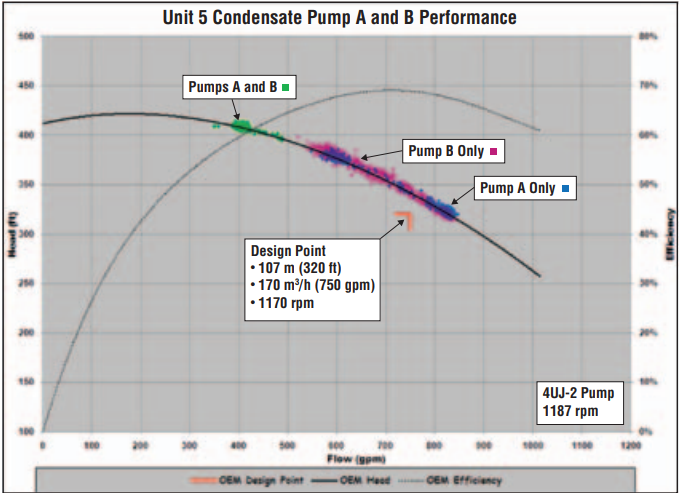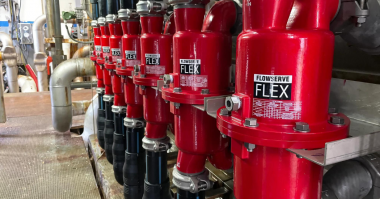Fifty-year-old Flowserve Condensate Pumps Perform to OEM Curve Specification
The owners of a Rocky Mountain (U.S.) coal-fired power station were all but convinced that the early 1960s vintage condensate pumps in one of its units needed to be replaced. Further, station operators expressed concerns as to the accuracy of the unit’s DCS data.
Flowserve Services and Solutions engineers recommended a technical assessment of the unit’s condensate system before making the final decision to purchase new pumps. Simultaneously, the validity of the DCS data would be evaluated. Utilizing IPS Wireless™ technology and instrumentation, Flowserve engineers determined both pumps matched well with the OEM curve and the DCS data trended closely with the test data. Simple changes in operating procedures were recommended to extend pump life further still. As a result, the pumps and condensate system are performing to original design expectations, while the owners have realized a net savings of approximately US$500 000.
A Colorado (U.S.) coal-fired power plant was evaluating the purchase and installation of new condensate pumps in one of its units. These would replace two nearly 50-year-old axially split, between bearings two-stage Worthington® pumps. Previous testing showed the pumps to be operating significantly away from their design point with decreasing reliability issues and increasing risks of damage from low flow recirculation.
Although the unit was originally designed to make full load running one pump at 100% capacity with the second as an installed spare, over the years the unit’s operation evolved to running both Condensate Pump A and Pump B together. Station management also had concerns with the accuracy of the unit’s DCS data. A quotation for new condensate pumps was submitted by Flowserve and the station owners were in the final stages of procurement approval.
The Services and Solutions team and local Flowserve sales engineer met with station management to suggest a system assessment before a final decision was made. The objectives of the assessment were to:
• Determine the current condition of the
condensate pumps
• Determine the feasibility of single pump operation
• Evaluate the accuracy of the station’s DCS data
A system assessment of the condensate pumps was performed during both single-pump and two-pump operation. IPS Wireless technology, including ultrasonic flow meters, pressure transducers and other instrumentation, was employed to determine flow, total developed head (TDH) and similarly critical performance characteristics. Redundant equipment was used to verify accuracy.
After analysis of the collected information, Flowserve engineers offered the following conclusions and recommendations:
• The pumps were performing properly, matching well with the OEM curve. There appeared to be no degradation in pump performance. Actual head of both pumps was slightly higher than design point because they were running at 1187 rpm instead of 1170 rpm, as listed on the OEM curve.
• With the pumps’ relatively low kW (hp) usage, little money would be saved by the installation of more efficient equipment.
• The plant was able to make full load by running Pump A alone, Pump B alone or Pump A and Pump B together. However, station operators were advised not to run both pumps together to avoid low flow operation. During low flow operation, pumps run well to the left of BEP. (See the pump performance curves.) This leads to discharge and/or suction recirculation and low flow cavitation, resulting in reduced bearing and seal life due to increased vibrations.
• DCS pressure and flow data and Flowserve test data trended well together. Differences in DCS total flow measurements, as indicated by the previous testing, were attributed to the failure to account for takeoff flows between the pumps and the orifice flow meter.
 The conclusion was that single condensate pump system operation would maximize reliability while helping to prevent cavitation and recirculation issues. Further, it would also significantly reduce energy and maintenance costs over the remaining life of the pumps by approximately 50% and 34%, respectively.
The conclusion was that single condensate pump system operation would maximize reliability while helping to prevent cavitation and recirculation issues. Further, it would also significantly reduce energy and maintenance costs over the remaining life of the pumps by approximately 50% and 34%, respectively.
The cost of the technical assessment was approximately  US$40,000, thereby saving nearly US$500 000 by avoiding
US$40,000, thereby saving nearly US$500 000 by avoiding
the purchase and installation of two new condensate pumps.





Comments